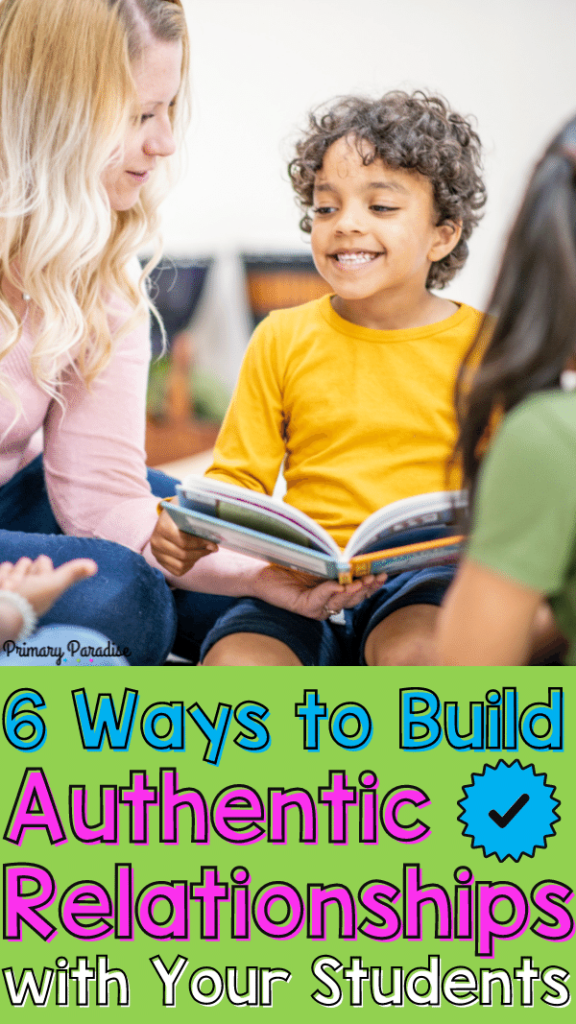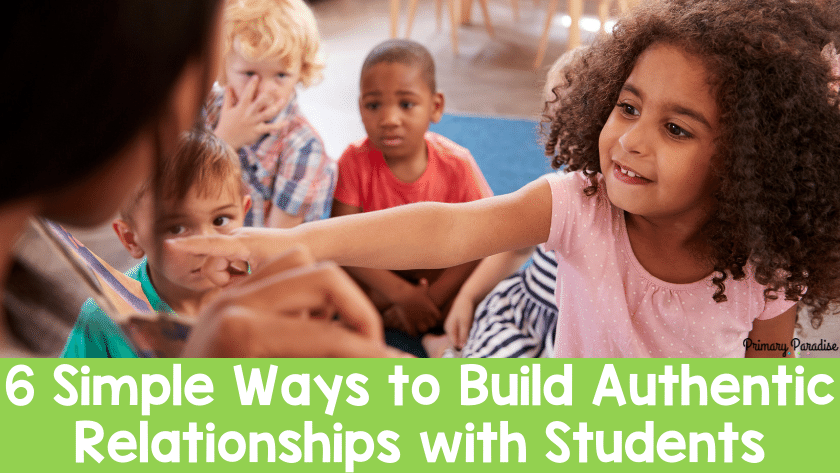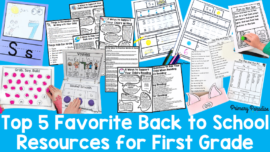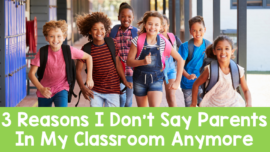Building relationships with students is an important part of teaching. However, building genuine, authentic relationships with your students is a whole lot more than just knowing that they love Pókemon or doing a TikTok dance with them. Here are 6 ways to build authentic relationships with students in your classroom.
A Word of Caution on Building Relationships
Before we begin, there are a few important things to keep in mind.
- Building authentic relationships takes time and effort.
- Just because you have a strong relationship with your students doesn’t mean that you won’t have management and behavior issues. Relationships are a start, but alone are not enough.
- You and your students will still make mistakes.
- Even the best teachers can’t always form a strong, authentic relationship with every student. Just try your best to connect as much as you can.
- Relationships involve forgiveness, acceptance, give and take, and the willingness to work at it.
Although social media posts might lead you to believe otherwise, relationships are not a quick fix, they’re not about being cool, and they are not always easy. With that being said, let’s dive right in.
How to Build Authentic Relationships with Your Students
1. Assume Good Intentions
This is a great rule of thumb for all relationships, but especially student relationships. Assume good intentions means just that. When you’re approaching a student, before you jump to conclusions, assume good intentions, assume they were trying their best.
Does that mean our students always actually have good intentions? No. But, it’s always a good place to start. Often times as teachers, we assume the worst of our students. If they make a mess, we might think they were being careless. If they push another student in line, we think they did it intentionally. Although those things might be true, it’s helpful to always assume good intentions first. Then, if after asking some questions we realize the didn’t have good intentions, we can work together to resolve the conflict or issue.
So, how might this look in the classroom?
Let’s assume you notice a student has trash and papers all over the floor around their desk. You might have the urge to immediately reprimand them. “Isaiah, look at this mess! The trashcan is right there! Pick it up right now!
However, if you assume good intentions, it might look like this. You notice the trash, but before you say anything, you stop and look at Isaiah. He is busy working on a project. He’s totally focused on his task, and is paying zero attention to anything else, including the mess he’s made. So, instead of reprimanding him, you might say, “Isaiah, I see you’re working hard on that! I’d love to hear about how it’s going, but I’m a bit distracted by the floor around you. What do you think you need to do first?” Most likely, Isaiah will smile at the compliment, clean up the mess, and then happily share his project so far.
You just turned what could have been a conflict into an opportunity to connect while also reminding him of his responsibility to keep his space tidy.
Let Them be Independent and Show Them You Trust Them
No one likes to be micromanaged, and that includes kids as well. Of course, our students need guidance and direction, but giving them space to be independent is super important as well. When we allow our students to do things independently, it does a few important things. First, it shows them that we trust them and are confident in their abilities. This is such an important part of building relationship. People open up when they feel trusted and can trust. If you’re not sure how to give your students more independence, you can find a list of 50 tasks students can do independently here.
Another way to show students you trust them is to teach them that they have the power to make appropriate choices from the beginning of the year. I love to start the year off with these lessons on choice. It shows my students right away that they have the power to make smart choices, and that I trust that they will. It also shows them that they can trust me to guide them as they’re making choices as well. In the end, giving our students independence and showing them that we trust them goes a long way towards building authentic relationships.
Let Them be Human
I think it has a lot to do with how schools are designed, but teachers often forget that students are real human beings with feelings, thoughts, struggles, emotions, good days, and bad days. I have found that one of the best ways to build authentic relationships is to treat our students like they’re humans. That means giving up trying to control things that don’t actually impact learning, allowing students to take a break when needed, letting them leave school at school, and giving them as much voice and choice as possible in our classrooms.
Here’s how it might look in your classroom:
Instead of expecting students to sit criss cross, hands folded, eyes ahead and perfectly still on the carpet, you might come up with expectations together. You could ask your students “How do you think we should be on the carpet so we can all learn? What can we agree on?” They might come up with something like this where they realize that listening can look different ways for different people. All of which are okay if we’re respecting each other.
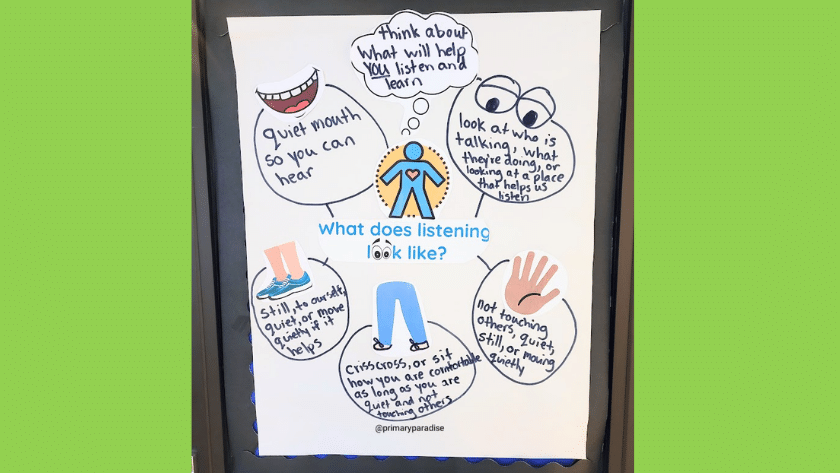
Instead of shouting at your rowdy class, it might mean taking a brain break to get their wiggles out.
Instead of students walking into a completed classroom on the first day of school with 5 rules posted on the wall, it might mean they walk into a classroom with blank bulletin boards and developing expectations together.
There are so many ways to treat our students like they’re human. It comes down to finding a few things we can do to allow them to be themselves.
Show Them You’re a Human
Relationships are a two way street. If we want our students to be real and vulnerable with us, we need to be real and vulnerable with them. Of course, this has to be within reason. You shouldn’t be telling your students about your love life drama, but you can and should be real with them. If you’re feeling sad or upset, it’s okay to let them know you’re having a bad day. You can tell them about your family, your hobbies, and the fact that you don’t actually sleep at school.
So often students think of their teachers as “only teachers”. Letting them see that you’re a real person who eats ice cream, does yoga, has bad hair days, makes mistakes, and sleeps in late on weekends gives them the opportunity to relate to you on a human level.
How might this look in your classroom?
If you have an infant at home and got very little sleep, you might start the day by saying, “Listen, friends. Alex is getting teeth so she was awake a lot last night. I am still here for you, but if I seem a bit slow and tired, that’s why.“
Or, if a student mentions that they watched a basketball game last night and you watched it as well, you could chat about it for a few minutes.
And lastly, it might look like apologizing to your class if you lose your temper or make a mistake. “I just want to take a minute before we move on to apologize for raising my voice just now. I should have taken a breath before I tried to speak to you about what happened.“
It really can be as simple as that. Just give them a chance to see that you’re a real human and not a teacher robot who lives at school.
Have Conversations Where You Really Listen to Them
Just like any relationship, student relationships require conversations. It’s important to actually listen to our students and give them a chance to speak and share their thoughts. Teachers spend so much of our time in the classroom talking, and students spend so much time listening. It’s important to make time each week, each day if possible, where students have a chance to share their thoughts.
How this might look in the classroom:
- Have a daily morning meeting and dedicate some times to sharing things that are important to students.
- If there’s an issue in the class, have a class meeting where everyone who wants to can share their thoughts and opinions.
- Ask a question of the day/week and force yourself to do little to no talking.
- When you pose a question to the class, give wait time.
- Don’t interrupt students.
- Model good listening skills so your students can follow your example.
Support Them Through Hard Things
Lastly, teachers can build authentic relationships by support students through hard things. Some of my strongest relationships have been with my students who struggled the most. In my early teaching career, I often did not handle these things well. Thankfully I’ve grown as a teacher.
When students are struggling, whether in school or at home, we can build authentic relationships by supporting them these ways:
- Listen without judgement.
- Allow them to feel their feelings.
- Tell them explicitly that you are there to help them and you will see them though it.
- Give them techniques to help them deal with whatever they’re struggling with.
- Seek outside support (counselors, nurse, etc.) if necessary.
- Scaffold so they can be successful.
- Give them clear expectations.
How might this look in your classroom?
Instead of telling an upset student to stop, you can give them techniques to work through their feelings such as to draw a picture of their feelings, take a walk to the water fountain and back, squeeze a stress ball, or look at books until they feel better.
Instead of continuing to give a student who is struggling to complete work the same work, you can have them check in with you after ever 3 problems they complete. Or, you could require them to only do half of the assignment. Once they are able to do that consistently, you can increase the expectations. Maybe they check in on you after 5 problems or complete 70% of the work. (Note: it’s very helpful to mark where they can stop for a visual cue.)
Instead of telling a student who is rolling on the carpet to “sit right” you can say, “The expectation is that your body is quiet and not distracting others. Please find a position and spot or let me know if you need my help.”
Instead of acting as judge and jury when there’s a conflict between students, you can work together to solve the conflict.
Instead of accusing students who are doing something wrong, you can ask questions. If a student is not working after you’ve given them an assignment instead of saying, “Come on, Kelvin. Get to work!” , you could ask, “Kelvin, do you need help getting started?” It might be that they didn’t understand the instructions or they are stuck on the first task.
Building authentic relationships with students isn’t going to make your classroom perfect, but it will help your students feel safe and better prepared to learn. It also makes teaching a much more enjoyable experience.
Keep reading and learning:
Help student resolve conflict and take ownership of their actions
How to create a morning routine for success
5 things to keep in mind at the beginning of the school year
